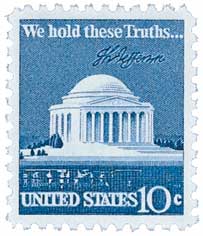
# 1520b - 1973 10c Jefferson Memorial, Error
Freaks and Errors are Missing From Most Collections
Nothing adds prestige to a stamp collection like a rarity, which is why error and freak stamps are so very desirable. Even the most common freak is much scarcer than the normal version of a stamp. And true errors are rare. Some of the most-treasured stamps in the world are error stamps. Now you can have them in your collection!
A Fascinating Philatelic Specialty
Errors and freaks are stamps not prepared according to their design specifications and mistakenly released to the public. Errors are stamps which have mistakes in color, perforation or design. Freaks are stamps which show an inconsistency in their production. There are three groups of stamps listed here: misperforated freaks, imperforate errors and missing color errors.
Misperforated freaks are stamps with perforations falling within the boundaries of the stamp’s design, rather than in the margins, usually caused by simple mechanical problems. With imperforate errors the perforation stage of production is completely omitted. The presence of a single mark from perforating machinery would disqualify it as a true error. This happens rarely and usually involves human error.
FREE Normal Stamp for Comparison!
When you order freak or error stamps we’ll send you the normal versions for FREE. Place them side by side in your album. When displayed in this way the error and freak stamps make the most dramatic presentation. They’ll look impressive in your album.
Set Your Collection Apart from the Rest...
Many collectors are unfamiliar with this important field of stamp collecting. Set your collection apart from the rest!
Dedication Of Jefferson Memorial
In the early 1900s, citizens of Washington, DC, recognized that a site on the shore of the Potomac River’s Tidal Basin, directly south of the White House, would be an ideal place for a high-profile monument. The Senate Park Commission proposed that a Pantheon-like structure be built there with “the statues of the illustrious men of the nation, or whether the memory of some individual shall be honored by a monument of the first rank may be left to the future.” But no further action was taken.
In 1918, the area was made into a beach, but it closed in 1925. That same year, the district held a design competition for a memorial in honor of Theodore Roosevelt. John Russell Pope’s design won, but Congress never allocated funds and the memorial was never built.
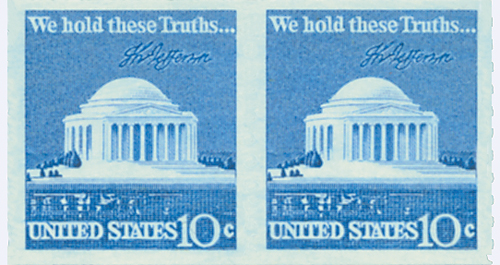
Then in 1934, President Franklin Roosevelt, a long-time admirer of Jefferson, suggested to the Commission of Fine Arts that they erect a memorial to Jefferson as part of the Federal Triangle Project. That year Congressman John J. Boylan supported Roosevelt’s proposal and pushed Congress to establish the Thomas Jefferson Memorial Commission. He succeeded and eventually received $3 million for the project.
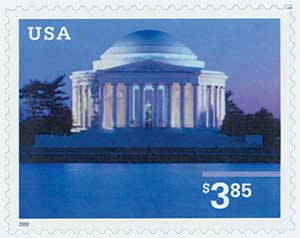
The Commission selected John Russell Pope, architect of the National Archives Building and original west building of the National Gallery of Art. Pope created plans for four different sites, and the Commission ultimately selected the one on the Tidal Basin because it was the most prominent site. Pope died before construction began, but his partners took over the project.
Construction finally began on December 15, 1938. And less than a year later, on November 15, 1939, President Roosevelt laid the cornerstone in a special ceremony. He called the memorial America’s “third great shrine” (following the Washington Monument and Lincoln Memorial). He went on to say, “In the current era in the erection of noble buildings in all parts of the country we recognize the enormous influence of Jefferson in the American application of classic art to homes and public buildings – an influence that makes itself felt today in the selection of the design for this very shrine for which we are laying the cornerstone.”
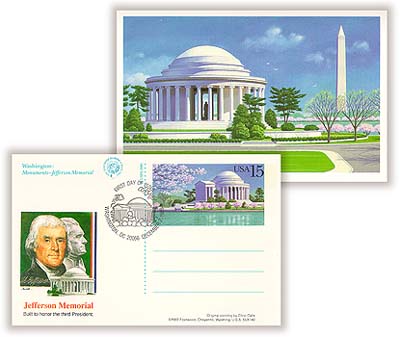
In spite of the support of Congress and the president, the memorial faced opposition even as it was being built. The Commission on Fine Arts never approved the memorial and printed a pamphlet opposing its design and location. Many people within the district opposed the memorial because it wasn’t part of the city’s original plan, created by Pierre L’Enfant. There was also outrage because the memorial’s construction meant the chopping down of cherry trees and flowering dogwoods. Eventually the design was made more conservative (some of the trees had to be removed, but more were planted) and construction was able to move forward.
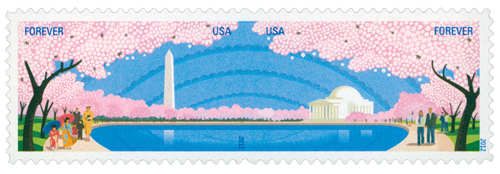
America’s entry into World War II slowed progress on the Memorial. Scheduled to be completed in 1941, it wasn’t done until 1943. That year, on April 13 (Jefferson’s 200th birthday) Roosevelt officially dedicated the monument. The ceremony was short – just 15 minutes. There was supposed to be a 19-foot tall bronze statue of Jefferson inside the memorial, but material shortages brought on by the war made that impossible. Instead, they placed a plaster cast of the statue painted in bronze in the center. The completed 10,000-pound statue was installed in 1947.
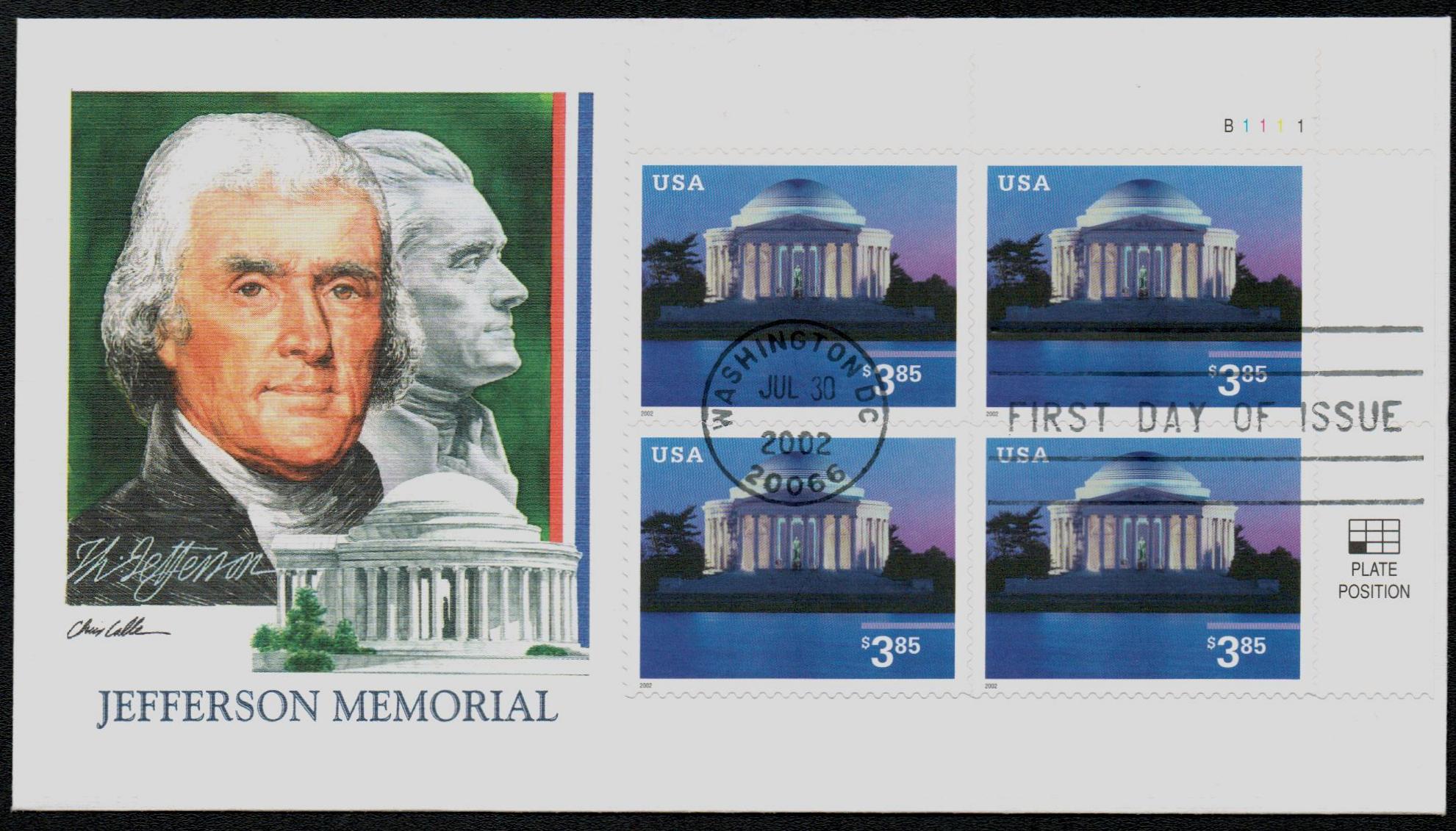
The memorial was designed to reflect Jefferson’s admiration of Roman architecture. The building is open to the elements and features circular marble steps, a portico, Ionic order columns, and a shallow dome. Passages of Jefferson’s writings are engraved on the walls.
The Memorial was added to the National Register of Historic Places in 1966 and in 2007 the American Institute of Architects ranked it fourth on the “List of America’s Favorite Architecture”.
Freaks and Errors are Missing From Most Collections
Nothing adds prestige to a stamp collection like a rarity, which is why error and freak stamps are so very desirable. Even the most common freak is much scarcer than the normal version of a stamp. And true errors are rare. Some of the most-treasured stamps in the world are error stamps. Now you can have them in your collection!
A Fascinating Philatelic Specialty
Errors and freaks are stamps not prepared according to their design specifications and mistakenly released to the public. Errors are stamps which have mistakes in color, perforation or design. Freaks are stamps which show an inconsistency in their production. There are three groups of stamps listed here: misperforated freaks, imperforate errors and missing color errors.
Misperforated freaks are stamps with perforations falling within the boundaries of the stamp’s design, rather than in the margins, usually caused by simple mechanical problems. With imperforate errors the perforation stage of production is completely omitted. The presence of a single mark from perforating machinery would disqualify it as a true error. This happens rarely and usually involves human error.
FREE Normal Stamp for Comparison!
When you order freak or error stamps we’ll send you the normal versions for FREE. Place them side by side in your album. When displayed in this way the error and freak stamps make the most dramatic presentation. They’ll look impressive in your album.
Set Your Collection Apart from the Rest...
Many collectors are unfamiliar with this important field of stamp collecting. Set your collection apart from the rest!
Dedication Of Jefferson Memorial
In the early 1900s, citizens of Washington, DC, recognized that a site on the shore of the Potomac River’s Tidal Basin, directly south of the White House, would be an ideal place for a high-profile monument. The Senate Park Commission proposed that a Pantheon-like structure be built there with “the statues of the illustrious men of the nation, or whether the memory of some individual shall be honored by a monument of the first rank may be left to the future.” But no further action was taken.
In 1918, the area was made into a beach, but it closed in 1925. That same year, the district held a design competition for a memorial in honor of Theodore Roosevelt. John Russell Pope’s design won, but Congress never allocated funds and the memorial was never built.

Then in 1934, President Franklin Roosevelt, a long-time admirer of Jefferson, suggested to the Commission of Fine Arts that they erect a memorial to Jefferson as part of the Federal Triangle Project. That year Congressman John J. Boylan supported Roosevelt’s proposal and pushed Congress to establish the Thomas Jefferson Memorial Commission. He succeeded and eventually received $3 million for the project.

The Commission selected John Russell Pope, architect of the National Archives Building and original west building of the National Gallery of Art. Pope created plans for four different sites, and the Commission ultimately selected the one on the Tidal Basin because it was the most prominent site. Pope died before construction began, but his partners took over the project.
Construction finally began on December 15, 1938. And less than a year later, on November 15, 1939, President Roosevelt laid the cornerstone in a special ceremony. He called the memorial America’s “third great shrine” (following the Washington Monument and Lincoln Memorial). He went on to say, “In the current era in the erection of noble buildings in all parts of the country we recognize the enormous influence of Jefferson in the American application of classic art to homes and public buildings – an influence that makes itself felt today in the selection of the design for this very shrine for which we are laying the cornerstone.”

In spite of the support of Congress and the president, the memorial faced opposition even as it was being built. The Commission on Fine Arts never approved the memorial and printed a pamphlet opposing its design and location. Many people within the district opposed the memorial because it wasn’t part of the city’s original plan, created by Pierre L’Enfant. There was also outrage because the memorial’s construction meant the chopping down of cherry trees and flowering dogwoods. Eventually the design was made more conservative (some of the trees had to be removed, but more were planted) and construction was able to move forward.

America’s entry into World War II slowed progress on the Memorial. Scheduled to be completed in 1941, it wasn’t done until 1943. That year, on April 13 (Jefferson’s 200th birthday) Roosevelt officially dedicated the monument. The ceremony was short – just 15 minutes. There was supposed to be a 19-foot tall bronze statue of Jefferson inside the memorial, but material shortages brought on by the war made that impossible. Instead, they placed a plaster cast of the statue painted in bronze in the center. The completed 10,000-pound statue was installed in 1947.

The memorial was designed to reflect Jefferson’s admiration of Roman architecture. The building is open to the elements and features circular marble steps, a portico, Ionic order columns, and a shallow dome. Passages of Jefferson’s writings are engraved on the walls.
The Memorial was added to the National Register of Historic Places in 1966 and in 2007 the American Institute of Architects ranked it fourth on the “List of America’s Favorite Architecture”.






